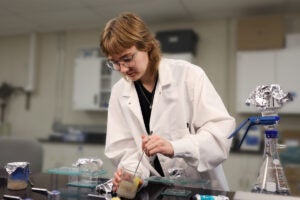AUSTIN, Texas—Astronomers think there might be a planet hiding in the dust circling the well-known star Vega, a resident of the constellation Lyra, the harp. Well, any alien denizens of that world are in for a treat: They are about to receive the first broadcast of the StarDate radio program.
Here on Earth, StarDate went on the air Oct. 1, 1978. Since Vega is about 25 light-years away, the radio signals of that first broadcast are just now reaching the star. The University of Texas at Austin McDonald Observatory produces the daily, two-minute looks at topics in astronomy and space science.
“We’re very proud to have kept this show on the air for a quarter-century,” said Frank Bash, director of McDonald Observatory. “Millions of people listen to StarDate. We are able to bring a little bit of the fascination of the heavens into their lives every day.”
Each month, StarDate offers a balance of astronomy and space-science topics. About half of each month’s programs are related to skywatching: eclipses, meteor showers, planetary conjunctions, stars and constellations, and so on. Other topics relate to important anniversaries, recent scientific discoveries, Earth’s place in the cosmos, and related topics that help place astronomy in a broader cultural perspective.
StarDate began as a telephone message service in 1977, and shortly thereafter went on the air in Austin as a daily radio program called “Have You Seen the Stars Tonight?” After receiving a grant from the National Science Foundation, the program began national distribution in 1978 under the name StarDate, with writer/producer Deborah Byrd and announcer Joel Block.
Now the longest-lived nationally broadcast science module on the nation’s airwaves, StarDate airs on about 400 stations around the country, in most major markets. About half of the stations that air StarDate are public radio stations, and half are commercial.
Writer/producer Damond Benningfield joined the show in 1991, as did Sandy Wood, StarDate’s current announcer.
“We try to show people that astronomy—and science in general—can be for everyone, not just guys in white lab coats,” said Benningfield. “It doesn’t take any science background to step outside and enjoy the crescent Moon, the planet Venus, or the bright stars in the sky—only an interest in the universe around us and a curiosity about what it all means.”
According to Executive Producer Sandra Preston, “The program has grown over the years to include not just the radio show, but also Spanish and German radio programs, as well as a magazine, Web site and education materials.” Preston joined the program in 1980.
StarDate magazine celebrates its 30th anniversary this year. This colorful 24-page bimonthly magazine brings science and stargazing to about 10,000 subscribers.
McDonald Observatory began producing the Spanish-language radio program Universo in 1995. Universo is heard on about 200 stations in the United States and Central America. The German version of StarDate, Sternzeit, airs on German public radio.
An extensive Web site, StarDate Online, contains information about astronomy and skywatching as well as a searchable database of radio scripts. Visitors can listen to past programs online, as well.
The program is recorded at Tequila Mockingbird studios in Austin by engineer Shayna Levin.
For more information contact: Rebecca Johnson, 512-475-6763.



